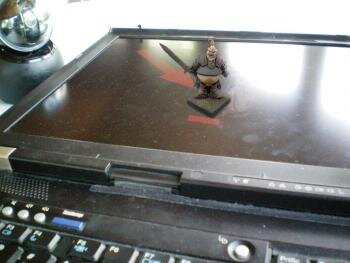Digital Dice: Electronic Game Boards

Video games bring the convenience of on-the-spot game play coupled with sexy visual effects and preparation-free automation. Wouldn’t it be great if tabletop games could be just as sexy and convenient? (Pictured on the author’s own electronic gameboard is Peeslag the obese Antipaladin, from Armorcast’s line of Nuisances miniatures, as painted by Enrico Nardini.)
The Digitally Integrated Tabletop project (Digital Tabletop for short) aims to do just that. The project, currently in development by this author, is being designed to deliver a tabletop gaming experience that is both more visually appealing and more convenient. I hope to make tabletop gaming a more accessible and enjoyable experience for all varieties of players, without hindering the creativity that is at the heart of tabletop
gaming’s greatness.
Now, there are already a whole slew of applications out there whose entire purpose is to streamline and manage some of the more cumbersome aspects of tabletop gaming. The problem I have always had with them as a GM is that it is very easy to get lost in all of your trackers and generators to the point where you are spending more time staring at a computer screen than interacting with your players.
The Digital Tabletop differs in that it is designed to be just as convenient and useful to players as it is to GMs. The Digital Tabletop will track the location of miniatures and place status information such as health points, spell effects, or temporary bonuses next to a miniature so that GM and players alike know exactly what is going on. Game mechanics with an area-of-effect will be visually represented so that everyone knows exactly what is going to be affected. Lingering spell effects will show up as visual effects, so when your player casts that Wall of Fire spell you do not have to break out that red pencil to represent it, you can represent it with an honest-to-goodness wall of fire!
And when miniatures are moved, their paths will be shown on the map and information on how far they can be moved will be displayed. No more breaking out rulers or counting grid squares!
So enough about what the Digital Tabletop does and more about how it is going to do it. If you are thinking that with a name like “Digital Tabletop” the project must involve some expensive and obscure hardware, you are in for a pleasant surprise. The Digitally Integrated Tabletop project will only use hardware that you probably already have! All you will need to get it going is a computer running the windows operating system, an USB webcam, and a computer monitor.
The original plan for the Digital Tabletop has the monitor lying on its back on the table and the miniatures sitting on top of the screen, with the webcam positioned so that it can watch the monitor and miniatures from above. If you are concerned that the miniatures will scratch up your screen, a piece of Plexiglas can be placed over it to protect it, and should not hinder the functionality at all.
If you have not guessed already, the Digital Tabletop functions by tracking pieces via the webcam, and the effects and automations are handled by an intuitive map program. The program keeps track of the locations of all your miniatures in terms of coordinate points, because each miniature has an unique set of coordinates the program is able to tell the difference between miniatures. When it notices a miniature is missing from its original spot, it knows it must have been moved, it then locates the errant miniature and assigns it a new unique coordinate point. The project is written in Python and is completely open source.
If you are a programmer and would like to contribute to this project or just want a copy of the code, feel free to email the author or to look for him on the Skirmisher Publishing LLC Forum.



